Back to Don's Maps
 Bushwalking Index
Bushwalking Index Dangars Gorge
Dangars Gorge is the first part of the Salisbury Waters gorge below Dangars Falls, between Dangars Falls and the bottom of the tourists track from Dangars Falls to Salisbury Waters which passes for the most part along a high dry ridge before dropping to Salisbury Waters. Dangars Gorge has many deep pools enclosed by sheer valley walls, and should only be attempted by very experienced and well prepared bushwalkers with canyoning and abseiling experience.
These photos and accompanying text are for the interest of armchair travellers only, and do not constitute comprehensive instructions for rockclimbers or bushwalkers.
The Dangars Gorge trip starting from below the falls is for very fit, very experienced and well prepared rockclimbers, and bushwalkers with rockclimbing experience, only. Some walkers will need ropes for some cliff descents, and all will need to be strong swimmers. I found a life vest and polypropylene long johns invaluable. The trip is best done in mid-summer during drought. There are many long pools to swim. It is possibly best done going upstream rather than downstream, using the made track to Salisbury Waters for one half of the journey. Fit, young parties with rock climbing experience have done the trip in a day. For reasons which will become obvious when you read this account, I do not advise camping in the gorge proper.
There is no track, it is very strenuous, and bush craft, topographical maps and compass are required. Sufficient water and food and survival equipment should be carried. Always carry a Personal Locator Beacon, and tell reliable people where you are going and how long your party will be away. Mobile phones do not work anywhere in the gorges for sure, and almost never even on top of the cliff line.

Starting down the obvious gully beside the falls.
Photo: Don Hitchcock November 2004
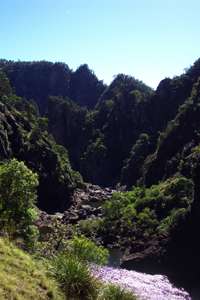
Nearly at the bottom. There is a large plunge pool to cross at the bottom of the descent, as well as many more long pools with sheer rock walls. I had brought a life vest, lilo and polypropylene long johns as well as equipment for an overnight camp.
Photo: Don Hitchcock November 2004
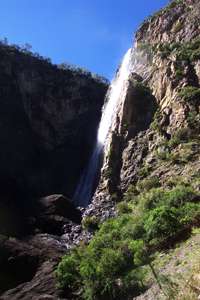
There was a large amount of water going over the falls, after a lot of rain in the area over the previous weeks.
Photo: Don Hitchcock November 2004

I found that the lilo was a waste of time. It buckled and was more hindrance than help. I deflated it after the first crossing, and stowed it in my backpack. I have thought since that a boogie board might be useful, so long as it could be stowed on your backpack easily after each swim.
These rocks are sometimes used by rockclimbers for practice in climbing and abseiling on the way down or up the gorge.
Photo: Don Hitchcock November 2004
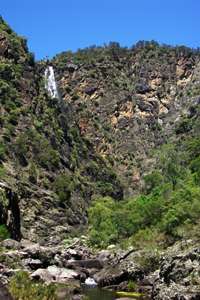
Last view of Dangars Falls. I realised at this point that I was making very poor time.
I wasted a lot of time by putting my pack inside a garbage bag each time I wanted to swim a pool, then removing the bag after the swim. I would have been much better off with the garbage bag inside the pack as a liner, putting all dry gear inside the liner, so that the pack was always waterproof. The bag is easily damaged on the rocks when putting it on the pack and taking it off, and if you enter a pool inadvertently (as I did later!) before waterproofing your bag, you have problems.
Nevertheless the rest of my equipment was fine. I was wearing polypropylene long johns top and bottom under the life jacket, and found that the wind made me feel a bit cold as soon as I got out of each long pool after swimming it, and then thirty seconds later I felt warm as most of the water drained off the polypropylene.
Photo: Don Hitchcock November 2004
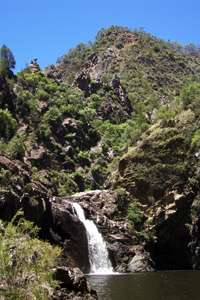
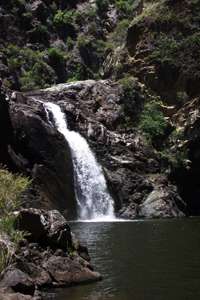
A beautiful little waterfall and pool. My camera ran out of batteries at this point, unfortunately.
Photo: Don Hitchcock November 2004
I continued to walk downstream, swimming several long pools. Some of the rock falls at the end were difficult for me to get down. At one point I thought that I could reach the next pool by jumping from the top to a rock one third of the way down, then to another, and then to the side of the pool, where I could do the pack-in-garbagebag thing again. Unfortunately, the first rock was slippery, and I lost my balance. The only thing I could do was to land on the second, and jump as far out as I could in order to miss the side of the pool completely. I succeeded, landing in deep water.
But that brought its own problems. The pack on my back slid up and threatened to push my head under. I recovered, grabbed my hat before it sank, and swam to the rock wall where a projecting rock enabled me to reorganise a little. I swam the rest of the pool with no problems, towing my pack behind me, though it had obviously taken in water.
Further on, I found another difficulty. At the end of a pool I came to a steep cliff, about five metres high, which I did not feel confident about getting down. I had brought a twelve metre length of rope, but there seemed to be nothing to secure it to. However there was a substantial rock jammed in a cleft at the top, with gravel all around it. I hoped that by digging out the gravel, it would expose the cleft beneath, and so it proved. I then put the rope around the rock, and the two ends easily reached the base of the cliff. I lowered my pack to the rocks below with an extra bit of Spectra cord I kept for pack hauling.
However I did not have a carabiner or waist rope or harness or slings of any kind. I remembered someone describing "classic" abseiling forty years earlier when I went on a rock climbing trip to Tasmania. The rope is wound around the body in a particular fashion, and it is a very fast way to use a rope to get to the bottom of a cliff in an emergency. Only having heard it described once a long time ago is not conducive to one's peace of mind, but I determined to give it a go.
I did it the way I remembered, and was delighted when I put my weight on the rope that it would obviously work. I "walked" down the slope, letting the rope out as I went, and I was jubilant when I reached the bottom. The rope itself came to me with ease when I pulled on it, and I was reminded of the elven rope which Sam carried in Lord of the Rings, and which came down of its own accord once the descent was completed.
But it was getting later and later. I swam several more pools, but the light was failing. At last I came to the end of a pool, and could not see how to get down the next rock fall. I looked around me, and saw that there was a level field of rocks and gravel, with the stream off to the right under a sheer wall. I decided to camp for the night.
I put up my tent, holding the cords down by putting rocks on top of the pegs. I looked ruefully at the uneven surface of rocks impressing their shapes on the floor of the tent, then I remembered the lilo, and reinflated it to lie on, since I don't carry an inflatable mattress.
I got out my down sleeping bag, but as soon as I lifted it from the pack, I knew it would be no use to me that night. It was sodden with water. My food bag was in much better shape, since I put all food in zip lock bags, and there was no water in the food, for which I was thankful. I always carry a space blanket, an aluminised mylar sheet for emergencies such as this, so I determined to lie on top of that and wrap the rest of its width across me to keep me warm.

The tent I was using at the time, shown here on a trip to Mihi Gorge.
I make my own tents, and this was my KiloBeater Mark II. It was made from Kmart shower curtains, had a carbon fibre pole and pegs, bridal veil insect screen, and worked very well. It weighed 880 grams with pole and pegs and stuff bag, and was very easy to put up and take down.
Photo: Don Hitchcock September 2004
Now with the tent up and things sorted for spending the night, I was a bit more cheerful, and I had just got a cup of turkish coffee into my hand when a rock fell, not too far from where I was sitting.
Odd, I thought.
Five minutes later, another one fell with a splash in the stream, then a shower of them, closer this time.
Then I saw my tent shake, as a more than fist sized rock punched through it.
This was distinctly not funny, but there was not a lot I could do about it. There were goats up above, who apparently came out in the early evening, knocking rocks off as they browsed on the cliffs above me. The average was five to seven minutes between rocks. It was now dark enough that I could see the sparks as the rocks struck the area I was camped on.
I made dinner, and ate it, thinking thoughts about "the prisoner ate a hearty meal before his execution" and retired to bed, since it was full dark by this time. I had a dry fine lambswool sweater and dry socks and dry lightweight microfibre trousers in ziplock bags, and put those on over my polypropylene gear, which was almost dry by this time with my body heat.
I lay on my back, with my EPIRB or Personal Locator Beacon on my chest attached by a lanyard to my shirt, so that if my legs were pinned by a rock I could activate it immediately. The rocks kept coming down, and about 11 pm a huge one landed with a loud "WHUMP!!!" and my tent was sprayed with water and gravel. My thoughts can be imagined.
There was, however, only one more after that, and everything quietened down, as presumably the goats moved further down the gorge. I literally did not sleep at all that night, despite the cessation of the falling rocks. I went over and over what I should do the next day, examined the map by torch light, and determined that I would try to get out via a ridge which looked almost possible on the true left bank of the river. Topographical maps are notoriously unreliable in matters of this kind, so it was by no means certain. It looked like it might "go" when I was looking at it earlier, before the light failed completely and I went into my tent, but I could not see far up the slope.
At first light, the rocks started again, so I got up and packed quickly, not bothering with either coffee or breakfast. First things first, I needed to get out of the danger zone, and quickly.
Looking at the gorge walls above, I realised that the best way up the ridge was at the end of the next pool. I found a fairly easy way down which was not obvious in yesterday's failing light, and swam my sixteenth pool of the trip.
I started up the ridge, and at first it was an easy scramble, once I got out of the rocks and onto the vegetated gorge wall.
Everything went well for a while, and I thought I was home free, until near the top a cliff appeared, which I could not bypass. Someone had been up here before me, however, and there was a substantial dead tree leaning against the cliff face. I attached my climbing rope to my pack, and scrambled up the tree with the end of the rope in my hand.
The tree, of course, got narrower towards the top.
There was then a short scramble from the end of the tree up a smooth rock surface to a slanting ledge on the cliff face.
From a secure position beside a stunted and gnarled metre high tree, I hauled my pack up beside me. The ledge was narrow and steep, and had dirt and rocks and scrub in it, making progress difficult, but I was able to follow it up until it debouched into a short, wider ledge at right angles to the first, from where I hauled my pack up beside me again, not without difficulty, through the vegetation.
This wider ledge then quickly led in a few metres to a very steep slope covered with grass interspersed with the smooth strap-shaped leaves of Lomandra longifolia, which I have found usually make good handholds if you grab a big fistful of leaves, and don't grab the thorny flower spike. I again hauled my pack after me when the slope lessened a little. I was now able to climb with my pack on my back, but the ridge remained steep right to the end.
I hauled myself over the edge at the top with relief. I made a cup of turkish, my first of the day, and very welcome too, and had something to eat. Life was good, I decided.
The return along the cliff line to the carpark at Dangars Falls was uneventful, but I had a distinct feeling of unreality when I got near and found children and their father playing with a ball, barbecues on the go, and peace and tranquillity all around.
As a direct result of this trip, I now routinely pack my sleeping bag in its own plastic garbage bag inside a backpack liner I've made out of silnylon which contains all the rest of my gear as well, and THEN add a plastic garbage bag between the pack and the liner just to be sure. I am an ultralightweight fanatic for equipment, but some things aren't worth skimping on.
The moral of the story is to do this trip in full summer when there is a drought on, and take along some burly twenty year old rockclimbers with equipment to make the trip a little easier for someone of my vintage. It was worth doing, however, and I don't regret anything.
I repaired the tent easily enough with a patch and some seam sealer, but my down sleeping bag took two weeks to dry out hanging on the line, and was never the same afterwards, it became strictly a summer bag. I make my own sleeping bags now, and if there is the remotest chance of a sleeping bag getting wet, my choice is for man-made fibre, which recovers easily from being wet, and retains a lot of its warmth, even when it does get wet.
 Bushwalking Index
Bushwalking Index Anyone (e.g. students, libraries, government agencies such as tourist bureaus, the general public) may use, print and publish the photographs taken by me and presented on this bushwalking file for any legitimate non-commercial purpose, at no cost, and without asking permission. However a note such as "Photo: Don Hitchcock" somewhere in the document would be appreciated if it is to be published.